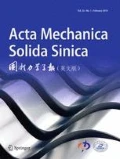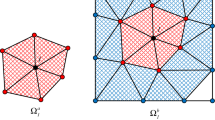Abstract
In this work, we further extended the face-based smoothed finite element method (FS-FEM) for modal analysis of three-dimensional solids using four-node tetrahedron elements. The FS-FEM is formulated based on the smoothed Galerkin weak form which employs smoothed strains obtained using the gradient smoothing operation on face-based smoothing domains. This strain smoothing operation can provide softening effect to the system stiffness and make the FS-FEM provide more accurate eigenfrequency prediction than the FEM does. Numerical studies have verified this attractive property of FS-FEM as well as its ability and effectiveness on providing reliable eigenfrequency and eigenmode prediction in practical engineering application.
Similar content being viewed by others
References
Zienkiewicz, O.C and Taylor, R.L., The Finite Element Method (5th edn). Butterworth Heinemann: Oxford, 2000.
Liu, G.R and Quek, S.S., Finite Element Method: a Practical Course. Butter-worth-heinemann: Burlington, MA, 2003.
Liu, G.R., Meshfree Methods: Moving Beyond the Finite Element Method (2nd Ed). CRC Press: Boca Raton, U.S.A., 2009.
Dokumaci, E., On superaccurate finite elements and their duals for eigenvalue computation. Journal of Sound and Vibration, 2006, 298(1–2): 432–438.
Zhang, Z.Q. and Liu, G.R., Upper and lower bounds for natural frequencies: a property of the smoothed finite element methods. International Journal for Numerical Method in Engineering, 2010, 84(2): 149–178.
Mackie, R.I., Improving finite element predictions of modes of vibration. International Journal for Numerical Method in Engineering, 1992, 33: 333–44.
Wiberg, N.E., Bausys, R. and Hager, P., Improved eigenfrequencies and eigenmodes in free vibration. Computers and Structures, 1999, 73: 79–89.
Avrashi, J. and Cook, R.D., New error estimation for C0 eigen-problems in finite element analysis. Engineering Computations, 1993, 10(3): 243–256.
Friberg, O., Moller, P., Makovicka, D. and Wiberg, N.E., An adaptive procedure for eigenvalue problems using hier-archical finite element method. International Journal for Numerical Method in Engineering, 1987, 24: 319–335.
Liu, G.R., A weakened weak (W2) form for a unified formulation of compatible and incompatible methods, Part I: Theory and Part II: Applications to solid mechanics problems. International Journal for Numerical Method in Engineering, 2010, 81: 1093–1156.
Liu, G.R., A Generalized gradient smoothing technique and the Smoothed bilinear form for Galerkin formulation of wide class of computational methods. International Journal for Numerical Method in Engineering, 2008, 5: 199–236.
Liu, G.R., Zhang, G.Y., Dai, K.Y., Wang, Y.Y., Zhong, Z.H., Li, G.Y. and Han, X., A linearly conforming point interpolation method (LC-PIM) for 2D solid mechanics problems. International Journal of Computational Methods, 2005, 2(4): 645–665.
Zhang, G.Y., Liu, G.R., Wang, Y.Y., Huang, H.T., Zhong, Z.H., Li, G.Y. and Han, X., A linearly conforming point interpolation method (LC-PIM) for three-dimensional elasticity problems. International Journal for Numerical Method in Engineering, 2007, 72(113): 1524–1543.
Liu, G.R., Nguyen, T.T., Nguyen, H.X. and Lam, K.Y., A node-based smoothed finite element method (NS-FEM) for upper bound solutions to solid mechanics problems. Computers and Structures, 2009, 87: 14–26.
Liu, G.R. and Zhang, G.Y., Upper bound solution to elasticity problems: a unique property of the linearly conforming point interpolation method (LC-PIM). International Journal for Numerical Method in Engineering, 2008, 74: 1128–1161.
Liu, G.R., Nguyen, T.T. and Lam, K.Y., An edge-based smoothed finite element method (ES-FEM) for static and dynamic problems of solid mechanics. Journal of Sound and Vibration, 2009, 320: 1100–1130.
He, Z.C., Liu, G.R., Zhong, Z.H., Wu, S.C., Zhang, G.Y. and Cheng, A.G., An edge-based smoothed finite element method (ES-FEM) for analyzing three-dimensional acoustic problems. Computer Methods in Applied Mechanics and Engineering, 2009, 199: 20–33.
He, Z.C., Cheng, A.G., Zhang, G.Y., Zhong, Z.H. and Liu, G.R., Dispersion error reduction for acoustic problems using the edge-based smoothed finite element method (ES-FEM). International Journal for Numerical Method in Engineering, 2011, 86(11): 1322–1338.
Nguyen, T.T., Liu, G.R., Lam, K.Y. and Zhang, G.Y., A face-based smoothed finite element method (FS-FEM) for 3D linear and geometrically nonlinear solid mechanics problems using 4-node tetrahedral elements. International Journal for Numerical Method in Engineering, 2009, 78: 324–353.
Nguyen, T.T., Liu, G.R., Vu-Do, H.C. and Nguyen, H.X., A face-based smoothed finite element method (FS-FEM) for visco-elastoplastic analyses of 3-D solids using tetrahedral mesh. Computer Methods in Applied Mechanics and Engineering, 2009, 198: 3479–3498.
He, Z.C., Liu, G.R., Zhong, Z.H., Cui, X.Y., Zhang, G.Y. and Cheng, A.G., A coupled edge-/face-based smoothed finite element method for structural-acoustic problems. Applied Acoustics, 2010, 71(10): 955–964.
Author information
Authors and Affiliations
Corresponding author
Additional information
Project supported by the National Project 973 (No. 2010CB328005) and the National Natural Science Foundation of China (No. 11202074). It is also partially supported by the Open Research Fund Program of the State Key Laboratory of Advanced Technology of Design and Manufacturing for Vehicle Body, Hunan University, P. R. China (No. 31175002). The authors also give sincere thanks to the support of Centre for ACES, Singapore-MIT Alliance (SMA) and National University of Singapore for the work.
Rights and permissions
About this article
Cite this article
He, Z., Li, G., Zhong, Z. et al. An Improved Modal Analysis for Three-Dimensional Problems using Face-Based Smoothed Finite Element Method. Acta Mech. Solida Sin. 26, 140–150 (2013). https://doi.org/10.1016/S0894-9166(13)60014-2
Received:
Revised:
Published:
Issue Date:
DOI: https://doi.org/10.1016/S0894-9166(13)60014-2




